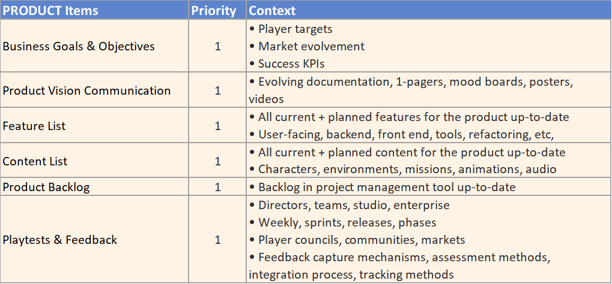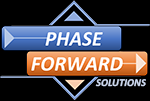PRODUCT
The product is the purpose of the project. It provides a business value for the organization by providing direct value to its customers.
Throughout production, the key aspects for successful product management are:
Establishing, and constantly communicating, a clear product vision that the project team can understand and leverage for decision-making
Having a clear, documented, always up-to-date, and properly prioritized scope (across all features & content) that allows for optimal visibility, planning and decision-making
Focusing on in-software reviews and their feedback loops, allowing for scrutinization of the sum of the player experience itself as opposed to progression of individual features
Below is a recap of the common Production Phases and examples of particular PRODUCT items that should be addressed per Phase. Actual items would depend on your particular project, but this may be a good starting point for you.
RESEARCH & EXPLORATION PHASE
The objective of the Research and Exploration Phase is to investigate, explore and propose the vision for a new product. The Team can dedicate time and focus to develop that creative vision through prototyping and proofs of concept, conducting research, and experimenting with the player experience they intend to build that aligns with the market potential. The R&E Phase allows teams to remain in an iterative development cycle, assume risks, try and fail, and test and refine the player experience until they are ready to move into the Conceptual Development Phase.
In the PRODUCT category, the focus is on building a product vision that is aligned with the company’s business & operational objectives, and confirming the product’s potential viability via market & consumer research. Conception workshops can help formulate the product vision and initial feature set, leading to early creative and technical briefs that provide insights on potential team compositions and technical production challenges. In addition, SWOT exercises (Strengths, Weaknesses, Opportunities, Threats) can facilitate decision-making when evaluating multiple product directions.
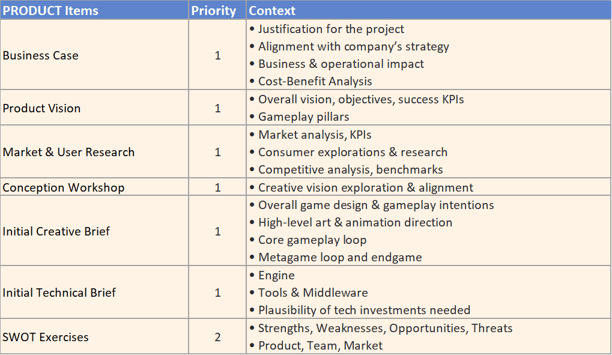

CONCEPTUAL DEVELOPMENT PHASE
The objective of the Conceptual Development Phase is to clarify the project intent and define the plan for pre-production. It is the opportunity for the team to formulate a matured creative vision and prove their intent to deliver an innovative, fun and successfully viable product. The Conceptual Development Phase allows for the formalizing of the direction for the setting, narrative, features, systems and core gameplay experiences and how they interact and support each other, along with the accompanying scope of content. The focus is also on understanding the market and business potential, along with the production planning roadmap for shipping the final product.
In the PRODUCT category, the focus is on cementing the product vision followed by building out the initial product scope: Feature List, Content List, Product Backlog. These are the 3 foundational artifacts that will influence all aspects of PEOPLE, PRODUCT, and PROCESS throughout the rest of development. In addition, development support area needs are clarified (legal, localization, user accounts, store, servers…), along with the expectations, deliverables & acceptance criteria of the project’s upcoming production gates. Another key clarification is the Vertical Slice (or MVP, depending on the scope of your project) deliverable for the end of Pre-Production, which should be the mechanism for establishing benchmark targets and de-risking the most imposing technical questions facing the teams.
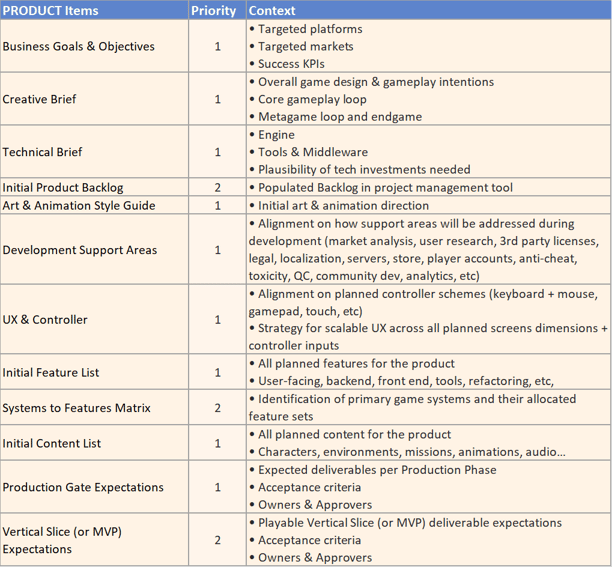

PRE-PRODUCTION PHASE
The objective of the Pre-Production Phase is to prove the core gameplay experiences, lock the Feature List and their design & technical specifications, and confirm expectations on scope and feasibility of content. All tech and game areas should be de-risked, with content creation pipelines proved out with actual production tools & workflows. Content and Feature benchmarks have been stood up to confirm pipelines, prove estimates, and set targets for production.
In the PRODUCT category, the focus is on answering open questions, solving risks, and establishing benchmarks by driving toward and delivering the product’s Vertical Slice (or MVP, depending on your project's scope). The Vertical Slice is a condensed, playable, final draft representation of the core experience of your game. The Feature List, Content List, and resulting Product Backlog will also be continually assessed and refined as the product vision becomes more and more a tangible experience in the player’s hands. In addition, product vision content (one-pagers, posters, concept art, videos) are created and continually utilized to crystalize the product vision, align the team on expectations, and facilitate prioritization and decision-making.
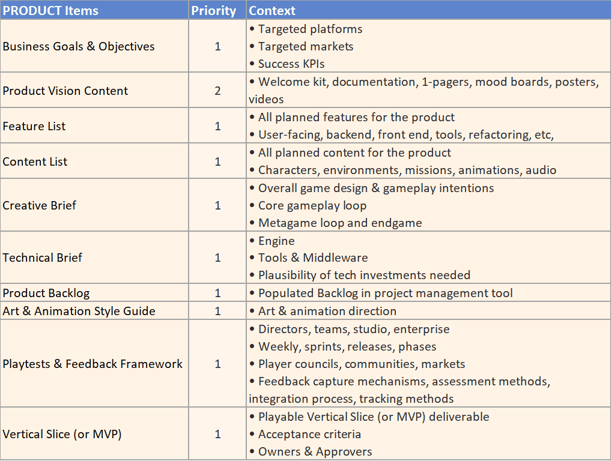

PRODUCTION PHASE
The Production Phase is focused on creating content and integrating assets into the game and executing on all aspects of product development. The team will implement the learnings and knowledge from the vertical slice or MVP delivery into the product development and production processes. In-software reviews and playtests combined with continuous scope & capacity assessments are required to adhere to quality and schedule requirements.
In the PRODUCT category, the focus is on continuous in-software reviews (both internal & external), monitoring quality and progress while balancing the funnel of feedback with the existing Product Backlog and product roadmap. The Feature List, Content List and Product Backlog may be trimmed or adjusted depending on progress, risks, challenges, and new opportunities, although this should follow your project's Change Request process. The key product deliverable at the end of the Production Phase is a strong Alpha that allows for an assessment of the start-to-finish player experience. "Alpha" indicates that all features are fully integrated (eg. all coding is complete, except for tuning/debugging), although content can still be placeholder as needed (art, animation, audio, etc).
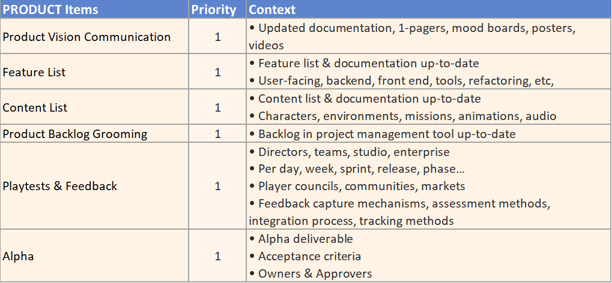

FINALING PHASE
In the Finaling Phase the game is tuned and balanced to provide a rounded and rewarding experience for the player. The focus in this phase is on reviews and playtests in order to acquire internal and external feedback from a wide variety of sources. Feedback analysis, prioritization and implementation takes place within the established change request processes relative to the remaining production timeline. The first Production Gate in the Finaling Phase is Beta, followed by a final push to product Launch.
In the PRODUCT category, the focus is on refining, polishing, and debugging the player experience to ensure expectations are met at the utmost quality relative to the scheduling constraints. Challenging prioritization decisions may need to be made, such as delaying some items to post-launch or cutting features & content outright, in order to improve quality overall. In-software reviews and internal & external playtests remain a critical mechanism for facilitating those difficult decisions as the product hits its Beta deliverable ("Beta" = fully functional, feature complete, content complete, and tuned), followed by its drive to Launch (final tuning and fully debugged for release).
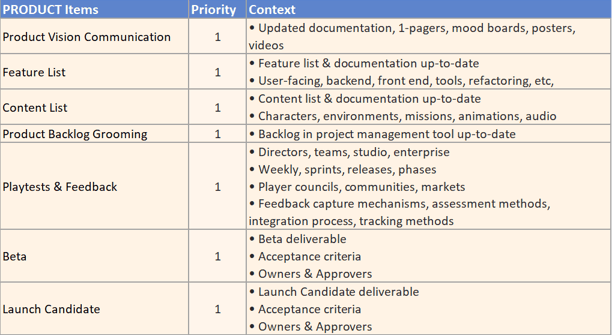

LIVE OPERATIONS
The focus of Live Operations is to expand and increase player engagement and boost the relationship with the community via regular content updates, events, new gameplay modes, modding, user tools, unique server playgrounds, new entry points, user generated content, UX evolutions, etc. Player feedback is continually assessed and where feasible integrated within the live operations product roadmap and release plan. In addition, the team is continuously optimizing production pipelines as well as the user experience to facilitate product updates and the player’s engagement.
In the PRODUCT category, the focus is on assessing, gathering, and incorporating feedback from the community into the overall Product Backlog and roadmap relative to the project’s evolving business goals and objectives. The product’s goals, objectives, and vision may evolve based on the player community sentiment and engagement. In addition, the Feature List, Content List, and Product Backlog will be continuously re-assessed at scheduled intervals to support the regular product updates throughout Live Operations.
